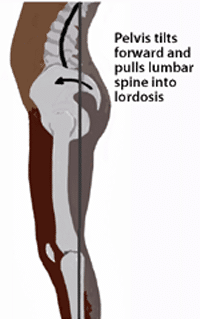For the majority of us runners, despite eager attempts to get our trainers on at any given opportunity, we have to bow down to the fact that we will spend more time each week at work than out running. It’s not fair but such is life!
For many of us, the time we spend not running involves hours of sitting or standing (depending on our job), be it in front of a computer, a whiteboard, steering wheel or shop counter. The common belief is that long term performing of these activities with a ‘poor posture’ can lead to niggles which if left untreated go on to hinder our ability to get the most out of a run or even stop us from getting out the front door.
This belief is commonly reinforced when we seek help from a health professional. A ‘postural assessment’ tells us that the pain we are suffering is the result of “poor posture”. We leave the clinic with a list of “corrective” exercises which, as long as we do them, should help us achieve a better posture, make the pain go away, and allow us to run pain free again. Unfortunately, as many runners have discovered, striving for an ‘ideal posture’ does not always see an end to the pain.
The rationale for postural assessment and corrective exercise is based on the long standing concept that our hours at work have left some of our muscles “weak and loose” and others “strong and tight”. And yet, strange as it may sound, research does not support the idea that the “tightness” of a muscle has much to do with pain or strength.
The thing is, whilst some people with say “forward shoulders” do indeed exhibit loose rhomboids and tight chest muscles, others do not. Likewise, some runners with forward shoulders may well suffer from pain between the shoulder blades, but others do not.
In other words, the relationship between posture and pain is not as clear as one may believe, and spending time trying to “correct” posture via targeted stretching and strengthening may not always be the best way forwards.
Research into posture and pain
 The “shape” of the lower back is often used as a benchmark for measuring “good posture”. An “anterior pelvic tilt” for example (where the front of the pelvis tips forwards and the back hikes up) is often blamed for lower back pain. However, research on lower back pain reveals some very interesting results:
The “shape” of the lower back is often used as a benchmark for measuring “good posture”. An “anterior pelvic tilt” for example (where the front of the pelvis tips forwards and the back hikes up) is often blamed for lower back pain. However, research on lower back pain reveals some very interesting results:
- Todd Hargrove, Feldenkrais Practitioner and man behind the excellent website BetterMovement.org details studies that have found adults with lumbar scoliosis and increased lower back curve are no more likely to have back pain than others.
- Other studies have shown no association between lower back pain and hamstring or psoas tightness, pelvic asymmetry, or leg length inequality under 2cm (the average leg length difference is 5.2 mm).
Now, that is not to say that the above cannot exist at the same time as pain. I have seen many runners with lower back pain who display an anterior pelvic tilt, and I have seen many who after performing stretches for the hip flexors eventually see the pain go. But I have also seen runners with similar degrees of anterior pelvic tilt who do not suffer from lower back pain, and runners who despite frequent attempts to stretch their hip flexors do not succeed in eliminating the pain. In other words, just because two things happen at the same time does not mean one causes the other.
Studies on the relationship between pain and lower back disc degeneration reveal similar anomalies. Hargrove lists many examples in which MRI (magnetic resonance imaging) scans have shown that although there are people with osteoarthritis or bulging discs who do suffer from pain, a high percentage of people with the same structural damage are not in pain. On top of that, there are people with no visible structural damage who are suffering!
With such little evidence linking posture to pain, or that striving to achieve a “correct” posture will help alleviate pain, it is natural that we therefore ask the question: what’s causing this pain and what can you do to stop it?
All about the brain
As we saw in last week’s article, An Introduction To Understanding Pain, research by modern neuroscientists such as Dr Lorimer Moseley and Dr David Butler is helping us get closer to understanding the true nature of pain. We now appreciate that pain does not come from a damaged tissue. It comes from the brain. Rather than a measure of tissue damage, it is a measure of how much danger the brain “perceives” you to be in, a warning alarm based on sensory input (visual, auditory, olfactory, etc.) as well as emotional input (motivation, stress, etc.) and other factors such as nutrition and respiration.
This may help explain why whilst some people with osteoarthritis or bulging discs suffer from pain, others do not. It helps explain how stress, fear, job satisfaction, etc. can make some people experience more pain than others, and others experience pain even if they have no structural damage at all.
How it works
Tissue damage can exist without the brain sending out alarm signals, just as the brain can send out alarm signals without the existence of any tissue damage. Blaming poor posture for pain is falling into the trap of believing pain comes from the body. It doesn’t. In fact, there is more evidence to suggest that poor posture may be the result of pain, as opposed to the cause.
Let’s imagine you have injured yourself.
- Nerve endings send information to the brain regarding the nature of the damage (Note: no pain has been triggered yet!).
- The brain interprets this information using sensory input (visual, auditory, olfactory, etc.), emotional input (motivation, stress, etc.), as well as memory of past experiences.
- The interpretation will be therefore be different for every individual (some of us handle certain types of pain better than others).
- The brain uses all of these inputs to make a decision on how to act and decides pain would now be a good way to encourage you to take action in order to protect yourself.
In other words pain is a defence, not an accurate measurement of tissue damage.
IMPORTANT: As we pointed out last week, no one is suggesting pain it is not real or significant. The distinction of pain being an output from the brain rather than an input from damaged tissue may have implications on treatment, but no one is saying ignore pain! If you are clearly injured, whether in pain or not, seeing a health professional is always recommended.
Implications for runners
If I have lost you a bit, I apologize. The thing is, understanding pain can help enormously when it comes to looking at ways to try and eliminate it. And that is after all what I want to do — get you pain-free and running. If I can leave you with one thought, let it be that:
Rather than just looking at mechanical ways to deal with pain, such as the stretching and strengthening programs typically associated with “corrective” exercise, we should also be targeting the brain and nervous system.
Science writer Paul Ingraham sums it up very nicely in his extensive article “Does Posture Matter?”:
The “behaviour” and condition of individual muscles is mostly trivial compared to the potent role of the central nervous system as the dictator of almost everything about both function and sensation. In short, it’s not “muscle imbalance” that makes people slump and hurt — it’s a brain thing.
Sadly, I can’t reduce the number of hours you have to work every week but I can guide you as to how to reduce the chance of niggles picked up at work ruining your run time — and that is where we will pick this up next week!
As always, feel free to leave your questions and comments below.
Happy running!
DISCLAIMER:
The material presented in this article is intended for informational purposes only. The information represents the opinion of the author, and does not constitute medical advice. This article is not intended to replace medical advice, nor to diagnose, prescribe or treat any illness, disease, or injury. The author expressly disclaims liability for any adverse effects that may result from the use, application or interpretation of the material in this article.
Matt Phillips is a Running Injury Specialist & Video Gait Analyst at StrideUK & Studio57clinic. Follow Matt on Twitter: @sportinjurymatt
References
http://www.bettermovement.org/2010/back-pain-myths-posture-core-strength-bulging-discs/
2. Ingraham, P.: Does Posture Matter? (2005-2013)
http://saveyourself.ca/articles/posture.php
3. Moseley, L. & Butler, D.: Explain Pain (2003)
https://www.youtube.com/watch?v=qv7Y26miLDA





4 Responses
I have found the first two articles in this series interesting, but lacking much in terms of what one can do about the pain that comes from our brain.
I have sciatic nerve pain and a change in posture actually does make a difference. Small rotations of my SI joint can trigger or relieve the pain.
Where is this series going?
Hi Michelle,
Apologies for not replying until now. Before answering, could I just check if you have read this article on ‘Mindful Movement’ as you may find a few answers there: https://runnersconnect.net/running-injury-prevention/running-injury-fix-mindful-movement/
What Michelle said! How do we target the brain and nervous system so as to not experience the pain? I too have problems with inflammation in the SI joint and am extremely interested in hearing how to correct this issue because as it stands, I am not able to run AT ALL. This is incredibly frustrating for me.
Hi Alison,
Many thanks for leaving a comment as it seems I never answered Michelle! As I have now asked Michelle, have you read this article on ‘Mindful Movement’? You may find a few answers there. I appreciate your frustration with persistent pain. It’s only in the last few year’s that science is beginning to see it from a hopefully more productive angle. Let me know if the article helps! Matt. https://runnersconnect.net/running-injury-prevention/running-injury-fix-mindful-movement/